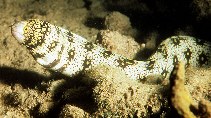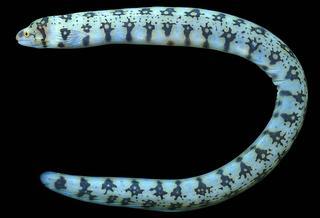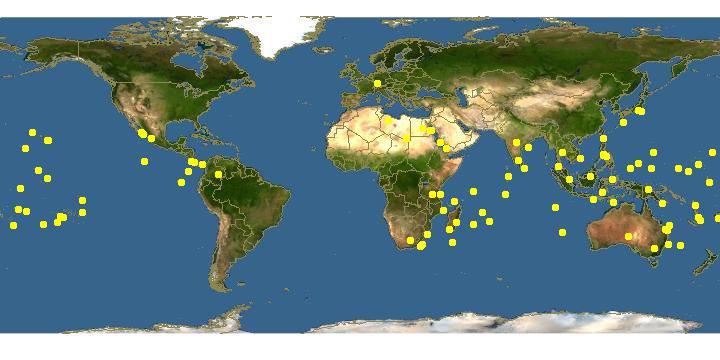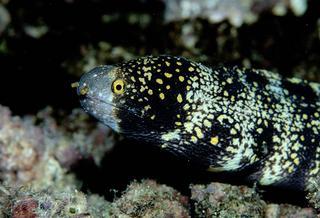|
| Links |
We parsed the following live from the Web into this page. Such content is managed by its original site and not cached on Discover Life. Please send feedback and corrections directly to the source. See original regarding copyrights and terms of use.
- Australian Faunal Directory
- FishBase
|
|
español |
|
|
Overview |
Main identification features
- eye and front nostril yellow
- white + 2 rows dark blotches and yellow spots
- teeth short, conical
Dorsal and anal fin rays developed as skin-covered ridges, but clearly evident; tip of tail blunt, with a skin-covered fin; short stout conical teeth at front of jaws; side of jaws with 1-2 rows of small close-set compressed nodular teeth.
White, with two rows of dendritic black blotches containing small yellow spots, these blotches sometimes forming more or less complete bars on head region; numerous small black spots between large blotches; front nostrils yellow.
Size: to 80 cm.
Habitat: rocky and rubble bottoms.
Depth: 1-30 m.
Widespread in the tropical Indo-Pacific from East Africa to the Americas; the central-west Gulf of California, and from central Mexico to Colombia, and all the oceanic islands.
Attributes
Abundance: Common.
Cites: Not listed.
Climate Zone: Northern Subtropical (Cortez Province + Sinaloan Gap); Northern Tropical (Mexican Province to Nicaragua + Revillagigedos); Equatorial (Costa Rica to Ecuador + Galapagos, Clipperton, Cocos, Malpelo).
Depth Range Max: 30 m.
Depth Range Min: 1 m.
Diet: mobile benthic crustacea (shrimps/crabs).
Eastern Pacific Range: Northern limit=29; Southern limit=-2; Western limit=-115; Eastern limit=-78; Latitudinal range=31; Longitudinal range=37.
Egg Type: Pelagic; Pelagic larva.
Feeding Group: Carnivore.
FishBase Habitat: Reef Associated.
Global Endemism: All Pacific (West + Central + East); Indo-Pacific only (Indian + Pacific Oceans); TEP non-endemic; "Transpacific" (East + Central &/or West Pacific); All species.
Habitat: Corals; Reef associated (reef + edges-water column & soft bottom); Rocks; Reef (rock &/or coral); Estuary; Mangrove; Mud; Sand & gravel; Soft bottom (mud, sand,gravel, beach, estuary & mangrove); Reef and soft bottom.
Inshore Offshore: Inshore; Inshore Only.
IUCN Red List: Not evaluated / Listed.
Length Max: 80 cm.
Regional Endemism: Island (s); Continent; Continent + Island (s); Eastern Pacific non-endemic; Tropical Eastern Pacific (TEP) non-endemic; All species.
Residency: Resident.
Salinity: Marine; Brackish.
Water Column Position: Bottom; Bottom only;
|
|
|
Names | |
|
|
|
Links to other sites | |
|
|
|
References |
- Ahl, J. N., 1789., Specimen ichthyologicum de Muraena et Ophichtho, quod venia exp. fac. Med. ups. Praeside Carol. Pet. Thunberg, etc. Upsala., Spec. Muraena Ophichtho., :1-14.
- Allen , G.R. and Robertson, D.R., 1994., Fishes of the Tropical Eastern Pacific., Crawford House Press Pty Ltd:1-332.
- Allen , G.R. and Robertson, D.R., 1997., An Annotated Checklist of the fishes of Clipperton Atoll, Tropical Eastern Pacific., Revista de Biologia Tropical, 45:813-843.
- Castro-Aguirre , J. L. , Balart , E. F. and Arvizu-Martínez, J., 1995., Contribución al conocimiento del origen y distribución de la ictiofauna del Golfo de California, México., Hidrobiologica, 5:57-78.
- Castro-Aguirre, J.L. and Balart, E.F., 2002., La ictiofauna de las islas Revillagigedos y sus relaciones zoogeograficas, con comentarios acerca de su origen y evolucion. En: Lozano-Vilano, M. L. (Ed.). Libro Jubilar en Honor al Dr. Salvador Contreras Balderas., Universidad Autonoma de Nuevo León:153-170.
- Findley, L.T., Hendrickx, M.E., Brusca, R.C., van der Heiden, A.M., Hastings, P.A., Torre, J., 2003., Diversidad de la Macrofauna Marina del Golfo de California, Mexico., CD-ROM versión 1.0. Projecto de la Macrofauna del Golfo . Derechos reservados de los autores y Conservación Internacional.
- Fischer , W. , Krup , F. , Schneider , W. , Sommer , C. , Carpenter , K. E. and Niem, V. H., 1995., Guia FAO para la Identificacion de Especies de para los fines de la Pesca. Pacifico Centro-Oriental. Volumen III. Vertebrados - Parte 2., FAO3:1201-1813.
- Lopez , M. I. and Bussing, W. A., 1982., Lista provisional de los peces marinos de la Costa Rica., Revista de Biologia Tropical, 30(1):5-26.
- Love, M.S., Mecklenburg, C.W., Mecklenburg, T.A., Thorsteinson, L.K., 2005., es of the West Coast and Alaska: a checklist of North Pacific and Artic Ocena species from Baja California to the Alaska-Yukon border., U.S. Department of the Interior, U.S. Geological Survey, Biological Resources Division, 288pp.
- Robertson , D.R. and Allen, G.A., 1996., Zoogeography of the shorefish fauna of Clipperton Atoll., Coral Reefs, 15:121-131.
- Rosenblatt , R.H. , McCosker , J.E. and Rubinoff, I., 1972., Indo-west Pacific fishes from the Gulf of Chiriqui, Panama., Contrib. Sci. Nat. Hist. Mus. Los Angeles Co., 234:18pp.
- Rubio, E.A., 1990., Ictiofauna Indopacifica asociada a los corales de la Isla de Gorgona., Revista de Ciencias, 2:97-105.
- Thomson , D.A. , Findley , L.T. and Kerstitch, A.N., 2000., Reef fishes of the Sea of Cortez., University of Texas Press(Revised Ed.):353.
- Vega, A.J., Villareal, N., 2003., Peces asociados a arrecifes y manglares en el Parque Nacional Coiba., Tecnociencia, 5:65-76.
- Villareal-Cavazos, A., Reyes-Bonilla, H., Bermúdez-Almada, B. and Arizpe-Covarrubias, O., 2000., Los peces del arrecife de Cabo Pulmo, Golfo de California, México: Lista sistemática y aspectos de abundancia y biogeografía., Rev. Biol. Trop., 48:413-424.
|
|
|
Acknowledgements | |
I thank Ashley MacDonald and John Pickering, University of Georgia, for technical support in building this page.
|
|
| Supported by | |
|
Following modified from Australian Faunal Directory
|
Top | See original
| &pull 20q v5.145 20180528: Error 301 Moved Permanently http://biodiversity.org.au/afd/taxa/c597dfe3-9be6-4e38-9865-a8ddaa3d4d5d/ |
|
Following modified from FishBase
|
Top | See original
http://www.fishbase.org/Summary/speciesSummary.php?genusname=Echidna&speciesname=nebulosa ---> http://192.134.151.83/Summary/speciesSummary.php?genusname=Echidna&speciesname=nebulosa
http://192.134.151.83/Summary/speciesSummary.php?genusname=Echidna&speciesname=nebulosa ---> https://fishbase.mnhn.fr/Summary/speciesSummary.php?genusname=Echidna&speciesname=nebulosa
https://fishbase.mnhn.fr/Summary/speciesSummary.php?genusname=Echidna&speciesname=nebulosa ---> https://fishbase.mnhn.fr/summary/Echidna-nebulosa.html
Echidna nebulosa, Starry moray : fisheries, aquarium

You can
sponsor
this page
Common name (e.g. trout)
Genus + Species (e.g. Gadus morhua)
-

-
About this page
-
Languages
-
User feedbacks
-
Citation
-
Uploads
-
Related species
-


 Starry moray
Add your observation in
Fish Watcher
Upload your
photos
and
videos
Starry moray
Add your observation in
Fish Watcher
Upload your
photos
and
videos
Pictures
|
Videos |
Google image
 Echidna nebulosa
Echidna nebulosa
Picture by
Randall, J.E.
Teleostei (teleosts) >
Anguilliformes
(Eels and morays) >
Muraenidae
(Moray eels) > Muraeninae
Etymology:
Echidna:
Greek, echidna = viper, 1847 (Ref.
45335
)
.
Environment: milieu / climate zone / depth range / distribution range
Ecology
Marine; reef-associated; depth range 1 - 48 m (Ref.
58302
), usually ? - 10 m (Ref.
30404
). Tropical; 32°N - 33°S, 27°E - 76°W
Indo-Pacific: Red Sea and East Africa (Ref.
33390
) and Persian Gulf (Ref.
68964
) to the Society Islands, north to southern Japan and the Hawaiian Islands, south to Lord Howe Island; throughout Micronesia. Eastern Central Pacific: southern Baja California, Mexico and from Costa Rica to northern Colombia (Ref.
9324
). Also found in Southeast Atlantic.
Size / Weight / Age
Maturity: L
m
?
range ? - ? cm
Max length : 100.0 cm TL male/unsexed; (Ref.
48635
); common length : 50.0 cm TL male/unsexed; (Ref.
3258
)
Dorsal
spines
(total): 0;
Dorsal
soft rays
(total): 0;
Anal
spines
: 0;
Anal
soft rays
: 0;
Vertebrae
: 119 - 126. Body white with 2 rows of large dendritic black blotches; black spots between blotches become irregularly linear with age. Yellow eyes (Ref.
48635
).
Found between rocks and corals of intertidal reef flats, also in shallow lagoon and seaward reefs to depths of at least 10 m (Ref.
9710
,
58302
). Benthic (Ref.
58302
). Nocturnal (Ref.
68964
). Feed mainly on crustaceans. Protogynous hermaphroditism unconfirmed for this species (Ref.
84746
). Safely kept with small aquarium fishes (Ref.
9710
). Solitary, seen usually in the open or with only head exposed (Ref 90102).
Life cycle and mating behavior
Maturity
|
Reproduction
|
Spawning
|
Eggs
|
Fecundity
|
Larvae
Protogyny unconfirmed (Ref.
84746
).
Chen, H.-M., K.-T. Shao and C.T. Chen
, 1994. A review of the muraenid eels (Family Muraenidae) from Taiwan with descriptions of twelve new records. Zool. Stud. 33(1):44-64. (Ref.
6934
)
IUCN Red List Status (Ref.
130435
)
Least Concern (LC)
; Date assessed:
16 August 2011
CITES
Not Evaluated
Not Evaluated
Threat to humans
Harmless
Human uses
Fisheries: minor commercial; aquarium: commercial
FAO - Publication:
search
|
FishSource
|
Sea Around Us
More information
Countries
FAO areas
Ecosystems
Occurrences
Introductions
Stocks
Ecology
Diet
Food items
Food consumption
Ration
Common names
Synonyms
Metabolism
Predators
Ecotoxicology
Reproduction
Maturity
Spawning
Spawning aggregation
Fecundity
Eggs
Egg development
Age/Size
Growth
Length-weight
Length-length
Length-frequencies
Morphometrics
Morphology
Larvae
Larval dynamics
Recruitment
Abundance
BRUVS
References
Aquaculture
Aquaculture profile
Strains
Genetics
Electrophoreses
Heritability
Diseases
Processing
Nutrients
Mass conversion
Collaborators
Pictures
Stamps, Coins Misc.
Sounds
Ciguatera
Speed
Swim. type
Gill area
Otoliths
Brains
Vision
Tools
Bio-Quiz
|
E-book
|
Field guide
|
Identification keys
|
Length-frequency wizard
|
Life-history tool
|
Point map
|
Classification Tree
|
Catch-MSY
|
Special reports
Check for Aquarium maintenance
|
Check for Species Fact Sheets
|
Check for Aquaculture Fact Sheets
Download XML
Summary page
|
Point data
|
Common names
|
Photos
Internet sources
AFORO (otoliths)
|
Aquatic Commons
|
BHL
|
Cloffa
|
BOLDSystems
|
Websites from users
|
Check FishWatcher
|
CISTI
|
Catalog of Fishes
:
genus
,
species
|
DiscoverLife
|
DORIS
|
ECOTOX
| FAO - Publication:
search
|
Faunafri
|
Fishipedia
|
Fishtrace
| GenBank:
genome
,
nucleotide
|
GloBI
|
Google Books
|
Google Scholar
|
Google
| IGFA World Record |
MitoFish
|
National databases
|
Otolith Atlas of Taiwan Fishes
|
Public aquariums
|
PubMed
|
Reef Life Survey
| Socotra Atlas |
Tree of Life
| Wikipedia:
Go
,
Search
| World Records Freshwater Fishing |
Zoological Record
Estimates based on models
Preferred temperature (Ref.
123201
): 24.9 - 29.3, mean 28.4 °C (based on 3674 cells).
Phylogenetic diversity index (Ref.
82804
): PD
50
= 0.5005 [Uniqueness, from 0.5 = low to 2.0 = high].
Bayesian length-weight: a=0.00034 (0.00022 - 0.00052), b=3.31 (3.19 - 3.43), in cm total length, based on LWR estimates for this species & (Sub)family-body (Ref.
93245
).
Trophic level (Ref.
69278
): 4.2 ±0.71 se; based on food items.
Resilience (Ref.
120179
): Low, minimum population doubling time 4.5 - 14 years (Preliminary K or Fecundity.).
Fishing Vulnerability (Ref.
59153
): High vulnerability (60 of 100).
Price category (Ref.
80766
):
Medium
.
Nutrients (Ref.
124155
): Calcium = 27.5 [14.8, 48.7] mg/100g; Iron = 0.421 [0.252, 0.924] mg/100g; Protein = 18.8 [16.5, 21.4] %; Omega3 = 0.102 [0.046, 0.288] g/100g; Selenium = 45.1 [24.8, 87.6] μg/100g; VitaminA = 58.5 [17.3, 181.5] μg/100g; Zinc = 0.886 [0.630, 1.224] mg/100g (wet weight);
Back to Search
Random Species
Back to Top
Accessed through:
Not available
FishBase mirror site :
localhost
Page last modified by :
mrius-barile
- 20 July 2016
Fatal error
: Uncaught ArgumentCountError: Too few arguments to function checkEcotox(), 1 passed in /var/www/html/summary/speciessummary.php on line 2304 and exactly 3 expected in /var/www/html/includes/speciessummary.lib.php:2579 Stack trace: #0 /var/www/html/summary/speciessummary.php(2304): checkEcotox() #1 {main} thrown in
/var/www/html/includes/speciessummary.lib.php
on line
2579
|
Updated: 2024-04-19 04:59:28 gmt
|








